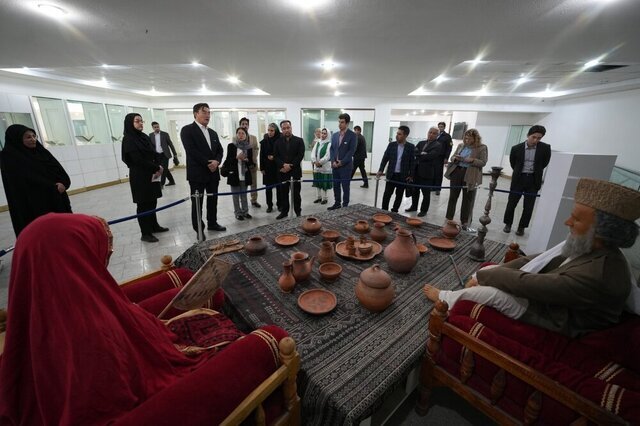South Korean ambassador says southeast Iran visit enriched his heritage insight

TEHRAN - The South Korean ambassador to Iran has said his recent personal visit to southeastern Iran, including a tour of the regional museum in Zahedan, gave him a deeper insight into the area’s cultural legacy and its connections to ancient Iranian traditions.
Referring to the visit, Ambassador Kim Junpyo wrote that he was grateful for the hospitality and guidance he received at the museum, calling the visit an impactful experience during his trip to the province, ISNA reported on Saturday.
He said he had been eager to visit the region because of its association with Rostam, the central hero of the Shahnameh, adding that Sistan is traditionally considered the birthplace of the legendary figure.
Kim said a prominent statue of Rostam in the museum lobby was his first impression of the site. He wrote that the artworks related to the Shahnameh demonstrated that locals regard Rostam not only as a mythological figure but as a symbol of regional identity and pride.
The ambassador also recounted a visit later that evening to a separate historic venue, where he received a detailed explanation of the “Seven Labors of Rostam” (The Tale of the Haft Khan) from a local historian. He said the narration helped him understand the moral themes, human challenges and symbolic meanings embedded in the epic.
Kim wrote that the stories highlighted qualities such as courage, wisdom, patience and responsibility, which he said continue to resonate among residents of the region.
He said the museum’s section on Shahr-e Sukhteh, a UNESCO World Heritage site, was another significant part of his visit. He noted that viewing original artefacts clarified the site’s role as a major center of the ancient Helmand civilization from 3200 to 1800 BCE, connected to cultures in Mesopotamia, the Indus Valley and Central Asia.
Among the artefacts, Kim cited an artificial eye dating to around 2800 BC and the so-called “animated goat cup,” often described as an early example of animation when rotated. He said the pieces reflected the technical skill and creativity of ancient Iranian societies.
He also noted imported materials from the Indus Valley, Afghanistan and Turkmenistan, indicating long-distance trade networks. A stone hand mill on display reminded him of similar traditional tools in Korea, a resemblance he said underscored shared aspects of daily life between the two cultures.
Kim wrote that the museum visit offered insight into the living memory of ancient civilizations, the identity of Sistan-Baluchestan’s people and Iran’s narrative traditions.
He expressed hope that Republic of Korea and Islamic Republic of Iran would expand cultural and historical cooperation, adding that the Southeast Regional Museum would continue to serve as a meaningful cultural bridge.
The following are excerpts from the ambassador’s written reflections on the trip:
When I entered the museum, the first thing that caught my attention was the striking statue of Rostam in the main lobby. His powerful stature and symbolic presence seemed to embody the spirit and cultural identity of Sistan and Baluchestan. Throughout the visit, I encountered many artefacts related to Rostam and the Shahnameh, and I clearly understood that the people of this region regard Rostam not only as a mythological hero but also as a symbol of local identity and pride.

That same night, at another historical site, I had a special opportunity to hear a detailed explanation from a local historian about the Seven Labours of Rostam. If what I observed in the museum was the starting point of my understanding of Rostam’s character, the historian’s engaging narration gave me the chance to grasp this charming epic on a deeper level. He beautifully explained not only Rostam’s battles but also the moral lessons, human challenges and symbolic meanings behind each labour. His reflections on Rostam’s virtues—such as courage, wisdom, patience and responsibility—and on how these valued qualities continue to resonate in the character of local people were deeply impressive. This reminded me that Rostam is not merely a mythological figure but a lasting cultural pillar of Iranian heritage.
After passing through the section filled with the spirit of the Shahnameh and Rostam, we reached the “Shahr-e Sukhteh” section of the museum, which became another highlight of my visit.
Although I knew that Shahr-e Sukhteh was inscribed as a UNESCO World Heritage Site in 2014, seeing the collection of actual surviving artefacts made it clear to me that this ancient settlement was not simply a local site, but truly an early centre of human civilization and long-distance cultural exchange.
I learned that Shahr-e Sukhteh, the principal center of the Helmand Civilization, thrived between 3200 and 1800 BC and maintained an active network with the civilizations of Mesopotamia, the Indus Valley and Central Asia. The artefacts displayed in the museum show that ancient eastern Iran possessed an independent and sophisticated civilization—something often overshadowed by the better-known cultures of Elam or Susa in western Iran.
The name “Shahr-e Sukhteh” comes from evidence of multiple widespread fires. Whether these fires were caused by warfare, natural disasters, or the gradual abandonment of the city remains a topic of scholarly debate, adding further intrigue to the visit.
One of the most astonishing artefacts was an artificial eye dating to around 2800 BC. Made from natural bitumen and delicate gold threads, it demonstrates the advanced medical and ornamental technology of the people of that era.
AM
